A Review of Current Development of Graphene Mechanics
Abstract
1. Introduction
2. Mechanical Properties of Graphene
2.1. Tension and Compression
2.2. Fracture
2.3. Shearing
2.4. Bending
2.5. Friction
2.6. Dynamics Properties
3. Mechanical Properties of Bilayer and Multilayer Graphene
3.1. Bilayer Graphene
3.2. Multilayer Graphene
4. Influence of Defect on Mechanical Properties of Graphene
4.1. Vacancies
4.2. Dislocations
4.3. Grain Boundaries
5. Strain and Defect Engineering: Electronic Properties of Graphene
6. Strain and Defect Engineering: Optical Properties of Graphene
7. Temperature Effect on Mechanical Properties of Graphene
8. Mechanical Properties of Graphene Derivatives
8.1. Graphane
8.2. Graphone
8.3. Graphyne
8.4. Fluorographene
8.5. Graphene Oxide
9. Conclusions and Outlook
Author Contributions
Funding
Acknowledgments
Conflicts of Interest
References
- Lee, C.; Wei, X.D.; Kysar, J.W.; Hone, J. Measurement of the elastic properties and intrinsic strength of monolayer graphene. Science 2008, 321, 385–388. [Google Scholar] [CrossRef] [PubMed]
- Pavol Lengvarský, J.B. Prediction of young’s modulus of graphene sheets by the finite element method. Am. J. Mech. Eng. 2015, 3, 225–229. [Google Scholar]
- Yeh, Y.K.; Hwu, C. A modified molecular-continuum model for estimating the strength and fracture toughness of graphene and carbon nanotube. Eng. Fract. Mech. 2017, 176, 326–342. [Google Scholar] [CrossRef]
- Rasool, H.I.; Ophus, C.; Klug, W.S.; Zettl, A.; Gimzewski, J.K. Measurement of the intrinsic strength of crystalline and polycrystalline graphene. Nat. Commun. 2013, 4, 2811. [Google Scholar] [CrossRef]
- Zhang, P.; Ma, L.L.; Fan, F.F.; Zeng, Z.; Peng, C.; Loya, P.E.; Liu, Z.; Gong, Y.J.; Zhang, J.N.; Zhang, X.X.; et al. Fracture toughness of graphene. Nat. Commun. 2014, 5, 3782. [Google Scholar] [CrossRef] [PubMed]
- Kudin, K.N.; Scuseria, G.E.; Yakobson, B.I. C2f, BN, and C nanoshell elasticity from ab initio computations. Phys. Rev. B 2001, 64, 235406. [Google Scholar]
- Liu, F.; Ming, P.M.; Li, J. Ab initio calculation of ideal strength and phonon instability of graphene under tension. Phys. Rev. B 2007, 76, 064120. [Google Scholar] [CrossRef]
- Zakharchenko, K.V.; Katsnelson, M.I.; Fasolino, A. Finite temperature lattice properties of graphene beyond the quasiharmonic approximation. Phys. Rev. Lett. 2009, 102, 046808. [Google Scholar] [CrossRef] [PubMed]
- Guo, J.G.; Zhou, L.J.; Kang, Y.L. Chirality-dependent anisotropic elastic properties of a monolayer graphene nanosheet. J. Nanosci. Nanotechnol. 2012, 12, 3159–3164. [Google Scholar] [CrossRef] [PubMed]
- Kalosakas, G.; Lathiotakis, N.N.; Galiotis, C.; Papagelis, K. In-plane force fields and elastic properties of graphene. J. Appl. Phys. 2013, 113, 134307. [Google Scholar] [CrossRef]
- Wei, D.; Song, Y.; Wang, F. A simple molecular mechanics potential for μm scale graphene simulations from the adaptive force matching method. J. Chem. Phys. 2011, 134, 184704. [Google Scholar] [CrossRef] [PubMed]
- Zhao, H.; Min, K.; Aluru, N.R. Size and chirality dependent elastic properties of graphene nanoribbons under uniaxial tension. Nano Lett. 2009, 9, 3012. [Google Scholar] [CrossRef] [PubMed]
- Wang, W. Study on Mechanical Properties and Variable-Temperature Raman Spectral Characteristics of Graphene-Substrate System. Ph.D. Thesis, Huazhong University of Science and Technology, Wuhan, China, 2016. [Google Scholar]
- Zhang, B.; Mei, L.; Xiao, H.F. Nanofracture in graphene under complex mechanical stresses. Appl. Phys. Lett. 2012, 101, 121915. [Google Scholar] [CrossRef]
- Sakhaee-Pour, A. Elastic properties of single-layered graphene sheet. Solid State Commun. 2009, 149, 91–95. [Google Scholar] [CrossRef]
- Liu, X.; Metcalf, T.H.; Robinson, J.T.; Houston, B.H.; Scarpa, F. Shear modulus of monolayer graphene prepared by chemical vapor deposition. Nano Lett. 2012, 12, 1013–1017. [Google Scholar] [CrossRef] [PubMed]
- Wei, Y.J.; Wang, B.L.; Wu, J.T.; Yang, R.G.; Dunn, M.L. Bending rigidity and gaussian bending stiffness of single-layered graphene. Nano Lett. 2013, 13, 26–30. [Google Scholar] [CrossRef] [PubMed]
- Ragab, T.; McDonald, J.; Basaran, C. Aspect ratio effect on shear modulus and ultimate shear strength of graphene nanoribbons. Diam. Relat. Mater. 2017, 74, 9–15. [Google Scholar] [CrossRef]
- Min, K.; Aluru, N.R. Mechanical properties of graphene under shear deformation. Appl. Phys. Lett. 2011, 98, 013113. [Google Scholar] [CrossRef]
- Wang, Q. Simulations of the bending rigidity of graphene. Phys. Lett. A 2010, 374, 1180–1183. [Google Scholar] [CrossRef]
- Los, J.H.; Fasolino, A.; Katsnelson, M.I. Scaling behavior and strain dependence of in-plane elastic properties of graphene. Phys. Rev. Lett. 2016, 116, 015901. [Google Scholar] [CrossRef] [PubMed]
- Jiang, J.W.; Chang, T.; Guo, X.; Park, H.S. Intrinsic negative poisson’s ratio for single-layer graphene. Nano Lett. 2016, 16, 5286. [Google Scholar] [CrossRef] [PubMed]
- Jiang, J.W.; Park, H.S. Negative poisson’s ratio in single-layer graphene ribbons. Nano Lett. 2016, 16, 2657. [Google Scholar] [CrossRef] [PubMed]
- Deng, B.; Hou, J.; Zhu, H.; Liu, S.; Liu, E.; Shi, Y.; Peng, Q. The normal-auxeticity mechanical phase transition in graphene. 2D Mater. 2017, 4, 021020. [Google Scholar] [CrossRef]
- Androulidakis, C.; Tsoukleri, G.; Koutroumanis, N.; Gkikas, G.; Pappas, P.; Parthenios, J.; Papagelis, K.; Galiotis, C. Experimentally derived axial stress-strain relations for two-dimensional materials such as monolayer graphene. Carbon 2015, 81, 322–328. [Google Scholar] [CrossRef]
- Tsoukleri, G.; Parthenios, J.; Papagelis, K.; Jalil, R.; Ferrari, A.C.; Geim, A.K.; Novoselov, K.S.; Galiotis, C. Subjecting a graphene monolayer to tension and compression. Small 2009, 5, 2397–2402. [Google Scholar] [CrossRef] [PubMed]
- Pradhan, S.C. Buckling of single layer graphene sheet based on nonlocal elasticity and higher order shear deformation theory. Phys. Lett. A 2009, 373, 4182–4188. [Google Scholar] [CrossRef]
- Pradhan, S.C.; Murmu, T. Small scale effect on the buckling of single-layered graphene sheets under biaxial compression via nonlocal continuum mechanics. Comput. Mater. Sci. 2009, 47, 268–274. [Google Scholar] [CrossRef]
- Civalek, O. Elastic buckling behavior of skew shaped single-layer graphene sheets. Thin Solid Films 2014, 550, 450–458. [Google Scholar] [CrossRef]
- Ashino, M.; Wiesendanger, R. Atomic-site-specific analysis on out-of-plane elasticity of convexly curved graphene and its relationship to sp(2) to sp(3) re-hybridization. Crystals 2018, 8, 102. [Google Scholar] [CrossRef]
- Lawn, B. Fracture of Brittle Solids; Cambridge University Press: Cambridge, UK, 1993. [Google Scholar]
- Moura, M.J.; Marder, M. Tearing of free-standing graphene. Phys. Rev. E Stat. Nonlinear Soft Matter Phys. 2013, 88, 032405. [Google Scholar] [CrossRef] [PubMed]
- Annett, J.; Cross, G.L.W. Self-assembly of graphene ribbons by spontaneous self-tearing and peeling from a substrate. Nature 2016, 535, 271–275. [Google Scholar] [CrossRef] [PubMed]
- Han, J.; Ryu, S.; Sohn, D. A feasibility study on the fracture strength measurement of polycrystalline graphene using nanoindentation with a cylindrical indenter. Carbon 2016, 107, 310–318. [Google Scholar] [CrossRef]
- Tsai, J.L.; Tu, J.F. Characterizing mechanical properties of graphite using molecular dynamics simulation. Mater. Des. 2010, 31, 194–199. [Google Scholar] [CrossRef]
- Scarpa, F.; Adhikari, S.; Chowdhury, R. The transverse elasticity of bilayer graphene. Phys. Lett. A 2010, 374, 2053–2057. [Google Scholar] [CrossRef]
- Shen, Y.K.; Wu, H.A. Interlayer shear effect on multilayer graphene subjected to bending. Appl. Phys. Lett. 2012, 100, 101909. [Google Scholar] [CrossRef]
- Zhang, H.; Guo, Z.; Gao, H.; Chang, T. Stiffness-dependent interlayer friction of graphene. Carbon 2015, 94, 60–66. [Google Scholar] [CrossRef]
- Cheng, Y.; Zhu, P.Z.; Li, R. The influence of vertical vibration on nanoscale friction: A molecular dynamics simulation study. Crystals 2018, 8, 129. [Google Scholar] [CrossRef]
- Li, R.; Song, C.G. The influence of hydroxyl groups on friction of graphene at atomic scale. Crystals 2018, 8, 167. [Google Scholar]
- Sakhaee-Pour, A.; Ahmadian, M.T.; Naghdabadi, R. Vibrational analysis of single-layered graphene sheets. Nanotechnology 2008, 19, 085702. [Google Scholar] [CrossRef] [PubMed]
- Tserpes, K.I.; Papanikos, P. Finite element modeling of single-walled carbon nanotubes. Compos. Part B 2005, 36, 468–477. [Google Scholar] [CrossRef]
- Li, C.; Chou, T.W. A structural mechanics approach for the analysis of carbon nanotubes. Int. J. Solids Struct. 2003, 40, 2487–2499. [Google Scholar] [CrossRef]
- Hashemnia, K.; Farid, M.; Vatankhah, R. Vibrational analysis of carbon nanotubes and graphene sheets using molecular structural mechanics approach. Comput. Mater. Sci. 2009, 47, 79–85. [Google Scholar] [CrossRef]
- Sadeghi, M.; Naghdabadi, R. Nonlinear vibrational analysis of single-layer graphene sheets. Nanotechnology 2010, 21, 105705. [Google Scholar] [CrossRef] [PubMed]
- Gupta, S.S.; Batra, R.C. Elastic properties and frequencies of free vibrations of single-layer graphene sheets. J. Comput. Theor. Nanosci. 2010, 7, 2151–2164. [Google Scholar] [CrossRef]
- Ansari, R.; Sahmani, S.; Arash, B. Nonlocal plate model for free vibrations of single-layered graphene sheets. Phys. Lett. A 2010, 375, 53–62. [Google Scholar] [CrossRef]
- Scarpa, F.; Chowdhury, R.; Kam, K.; Adhikari, S.; Ruzzene, M. Dynamics of mechanical waves in periodic graphene nanoribbon assemblies. Nanoscale Res. Lett. 2011, 6, 1–10. [Google Scholar] [CrossRef] [PubMed]
- Mianroodi, J.R.; Niaki, S.A.; Naghdabadi, R.; Asghari, M. Nonlinear membrane model for large amplitude vibration of single layer graphene sheets. Nanotechnology 2011, 22, 305703. [Google Scholar] [CrossRef] [PubMed]
- Chowdhury, R.; Adhikari, S.; Scarpa, F.; Friswell, M.I. Transverse vibration of single-layer graphene sheets. J. Phys. D Appl. Phys. 2011, 44, 205401–205411. [Google Scholar] [CrossRef]
- Akgöz, B.; Civalek, Ö. Free vibration analysis for single-layered graphene sheets in an elastic matrix via modified couple stress theory. Mater. Des. 2012, 42, 164–171. [Google Scholar] [CrossRef]
- Baykasoglu, C.; Mugan, A. Dynamic analysis of single-layer graphene sheets. Comput. Mater. Sci. 2012, 55, 228–236. [Google Scholar] [CrossRef]
- Alyokhin, V.V.; Annin, B.D.; Babichev, A.V.; Korobeynikov, S.N. Free vibrations and buckling of graphene sheets. Mech. Solids 2013, 58, 487–490. [Google Scholar] [CrossRef]
- Mirparizi, M.; Aski, F.S. Interlayer shear effect on vibrational behavior of bilayer graphene using the molecular mechanics simulation. Propuls. Power Res. 2016, 5, 250–260. [Google Scholar] [CrossRef]
- Jang, B.; Mag-isa, A.E.; Kim, J.-H.; Kim, B.; Lee, H.-J.; Oh, C.-S.; Sumigawa, T.; Kitamura, T. Uniaxial fracture test of freestanding pristine graphene using in situ tensile tester under scanning electron microscope. Extreme Mech. Lett. 2017, 14, 10–15. [Google Scholar] [CrossRef]
- Li, C.; Chou, T.W. Elastic moduli of multi-walled carbon nanotubes and the effect of van der waals forces. Compos. Sci. Technol. 2003, 63, 1517–1524. [Google Scholar] [CrossRef]
- Cho, J.; Luo, J.J.; Daniel, I.M. Mechanical characterization of graphite/epoxy nanocomposites by multi-scale analysis. Compos. Sci. Technol. 2007, 67, 2399–2407. [Google Scholar] [CrossRef]
- Wang, G.R.; Dai, Z.H.; Wang, Y.L.; Tan, P.H.; Liu, L.Q.; Xu, Z.P.; Wei, Y.G.; Huang, R.; Zhang, Z. Measuring interlayer shear stress in bilayer graphene. Phys. Rev. Lett. 2017, 119, 036101. [Google Scholar] [CrossRef] [PubMed]
- Neek-Amal, M.; Peeters, F.M. Nanoindentation of a circular sheet of bilayer graphene. Phys. Rev. B 2010, 81, 235421. [Google Scholar] [CrossRef]
- Kordkheili, S.A.H.; Moshrefzadeh-Sani, H. Mechanical properties of double-layered graphene sheets. Comput. Mater. Sci. 2013, 69, 335–343. [Google Scholar] [CrossRef]
- Zhang, J.F.; Zhao, J.J. Mechanical properties of bilayer graphene with twist and grain boundaries. J. Appl. Phys. 2013, 113, 043514. [Google Scholar] [CrossRef]
- Zhang, Y.Y.; Wang, C.M.; Cheng, Y.; Xiang, Y. Mechanical properties of bilayer graphene sheets coupled by sp(3) bonding. Carbon 2011, 49, 4511–4517. [Google Scholar] [CrossRef]
- Yin, H.; Qi, H.J.; Fan, F.; Zhu, T.; Wang, B.; Wei, Y. Griffith criterion for brittle fracture in graphene. Nano Lett. 2015, 15, 1918–1924. [Google Scholar] [CrossRef] [PubMed]
- Datta, D.; Nadimpalli, S.P.V.; Li, Y.; Shenoy, V.B. Effect of crack length and orientation on the mixed-mode fracture behavior of graphene. Extreme Mech. Lett. 2015, 5, 10–17. [Google Scholar] [CrossRef]
- Muniz, A.R.; Machado, A.S.; Maroudas, D. Mechanical behavior of interlayer-bonded nanostructures obtained from bilayer graphene. Carbon 2015, 81, 663–677. [Google Scholar] [CrossRef]
- Wang, L.; Zhang, Q. Elastic behavior of bilayer graphene under in-plane loadings. Curr. Appl. Phys. 2012, 12, 1173–1177. [Google Scholar] [CrossRef]
- Chandra, Y.; Chowdhury, R.; Adhikari, S.; Scarpa, F. Elastic instability of bilayer graphene using atomistic finite element. Phys. E 2011, 44, 12–16. [Google Scholar] [CrossRef]
- Chandra, Y.; Chowdhury, R.; Scarpa, F.; Adhikaricor, S. Vibrational characteristics of bilayer graphene sheets. Thin Solid Films 2011, 519, 6026–6032. [Google Scholar] [CrossRef]
- Nazemnezhad, R.; Kamali, K.; Hosseini-Hashemi, S. Study on tensile-compressive and shear effects of van der waals interactions on free vibration of bilayer graphene nanoribbons. Meccanica 2016, 52, 1–20. [Google Scholar] [CrossRef]
- Wang, K.F.; Wang, B.L.; Zeng, S. Small scale effect on the pull-in instability and vibration of graphene sheets. Microsyst. Technol. 2017, 23, 2033–2041. [Google Scholar] [CrossRef]
- Zhang, Y.; Zhang, L.W.; Liew, K.M.; Yu, J.L. Free vibration analysis of bilayer graphene sheets subjected to in-plane magnetic fields. Compos. Struct. 2016, 144, 86–95. [Google Scholar] [CrossRef]
- Wu, Z.T.; Hu, F.Y.; Zhang, Y.; Gao, Q.; Chen, Z.P. Mechanical analysis of double-layered circular graphene sheets as building material embedded in an elastic medium. J. Cent. South Univ. 2017, 24, 2717–2724. [Google Scholar] [CrossRef]
- Wu, Z.T.; Zhang, Y.; Hu, F.Y.; Gao, Q.; Xu, X.Y.; Zheng, R.H. Vibration analysis of bilayered graphene sheets for building materials in thermal environments based on the element-free method. J. Nanomater. 2018, 2018, 6508061. [Google Scholar] [CrossRef]
- Cranford, S.; Buehler, M.J. Twisted and coiled ultralong multilayer graphene ribbons. Model. Simul. Mater. Sci. Eng. 2011, 19, 054003. [Google Scholar] [CrossRef]
- Yang, L.; Guo, Y.J.; Zhang, Q. Frictional behavior of strained multilayer graphene: Tuning the atomic scale contact area. Diam. Relat. Mater. 2017, 73, 273–277. [Google Scholar] [CrossRef]
- Wang, J.; He, X.; Kitipornchai, S.; Zhang, H. Geometrical nonlinear free vibration of multi-layered graphene sheets. J. Phys. D Appl. Phys. 2011, 44, 135401. [Google Scholar] [CrossRef]
- Jomehzadeh, E.; Saidi, A.R. A study on large amplitude vibration of multilayered graphene sheets. Comput. Mater. Sci. 2011, 50, 1043–1051. [Google Scholar] [CrossRef]
- Lu, L.; Ru, C.Q.; Guo, X.M. Vibration of a multilayer graphene sheet under layerwise tension forces. Int. J. Mech. Sci. 2017, 121, 157–163. [Google Scholar] [CrossRef]
- Bunch, J.S.; van der Zande, A.M.; Verbridge, S.S.; Frank, I.W.; Tanenbaum, D.M.; Parpia, J.M.; Craighead, H.G.; McEuen, P.L. Electromechanical resonators from graphene sheets. Science 2007, 315, 490–493. [Google Scholar] [CrossRef] [PubMed]
- Garcia-Sanchez, D.; van der Zande, A.M.; Paulo, A.S.; Lassagne, B.; McEuen, P.L.; Bachtold, A. Imaging mechanical vibrations in suspended graphene sheets. Nano Lett. 2008, 8, 1399–1403. [Google Scholar] [CrossRef] [PubMed]
- Banhart, F.; Kotakoski, J.; Krasheninnikov, A.V. Structural defects in graphene. ACS Nano 2011, 5, 26–41. [Google Scholar] [CrossRef] [PubMed]
- Amorim, R.G.; Fazzio, A.; Antonelli, A.; Novaes, F.D.; da Silva, A.J.R. Divacancies in graphene and carbon nanotubes. Nano Lett. 2007, 7, 2459–2462. [Google Scholar] [CrossRef] [PubMed]
- Lehtinen, O.; Kotakoski, J.; Krasheninnikov, A.V.; Tolvanen, A.; Nordlund, K.; Keinonen, J. Effects of ion bombardment on a two-dimensional target: Atomistic simulations of graphene irradiation. Phys. Rev. B 2010, 81, 153401. [Google Scholar] [CrossRef]
- Zandiatashbar, A.; Lee, G.H.; An, S.J.; Lee, S.; Mathew, N.; Terrones, M.; Hayashi, T.; Picu, C.R.; Hone, J.; Koratkar, N. Effect of defects on the intrinsic strength and stiffness of graphene. Nat. Commun. 2014, 5, 3186. [Google Scholar] [CrossRef] [PubMed]
- Lee, G.H.; Cooper, R.C.; An, S.J.; Lee, S.; Van, D.Z.A.; Petrone, N.; Hammerberg, A.G.; Lee, C.; Crawford, B.; Oliver, W. High-strength chemical-vapor-deposited graphene and grain boundaries. Science 2013, 340, 1073–1076. [Google Scholar] [CrossRef] [PubMed]
- López-Polín, G.; Gómez-Navarro, C.; Parente, V.; Guinea, F.; Katsnelson, M.I.; Pérez-Murano, F.; Gómez-Herrero, J. Increasing the elastic modulus of graphene by controlled defect creation. Nat. Phys. 2014, 11, 26–31. [Google Scholar] [CrossRef]
- Kvashnin, D.G.; Sorokin, P.B. Effect of ultrahigh stiffness of defective graphene from atomistic point of view. J. Phys. Chem. Lett. 2015, 6, 2384–2387. [Google Scholar] [CrossRef] [PubMed]
- Lee, G.; Yang, G.; Cho, A.; Han, J.W.; Kim, J. Defect-engineered graphene chemical sensors with ultrahigh sensitivity. Phys. Chem. Chem. Phys. 2016, 18, 14198–14204. [Google Scholar] [CrossRef] [PubMed]
- Warner, J.H.; Margine, E.R.; Mukai, M.; Robertson, A.W.; Giustino, F.; Kirkland, A.I. Dislocation-driven deformations in graphene. Science 2012, 337, 209–212. [Google Scholar] [CrossRef] [PubMed]
- Jeong, B.W.; Ihm, J.; Lee, G.D. Stability of dislocation defect with two pentagon-heptagon pairs in graphene. Phys. Rev. B Condens. Matter 2008, 78, 165403. [Google Scholar] [CrossRef]
- Grantab, R.; Shenoy, V.B.; Ruoff, R.S. Anomalous strength characteristics of tilt grain boundaries in graphene. Science 2010, 330, 946–948. [Google Scholar] [CrossRef] [PubMed]
- Wei, Y.; Wu, J.; Yin, H.; Shi, X.; Yang, R.; Dresselhaus, M. The nature of strength enhancement and weakening by pentagon-heptagon defects in graphene. Nat. Mater. 2012, 11, 759–763. [Google Scholar] [CrossRef] [PubMed]
- Song, Z.G.; Artyukhov, V.I.; Yakobson, B.I.; Xu, Z.P. Pseudo hall-petch strength reduction in polycrystalline graphene. Nano Lett. 2013, 13, 1829–1833. [Google Scholar] [CrossRef] [PubMed]
- Sha, Z.D.; Quek, S.S.; Pei, Q.X.; Liu, Z.S.; Wang, T.J.; Shenoy, V.B.; Zhang, Y.W. Inverse pseudo hall-petch relation in polycrystalline graphene. Sci. Rep. UK 2014, 4, 5991. [Google Scholar] [CrossRef] [PubMed]
- Liu, T.H.; Pao, C.W.; Chang, C.C. Effects of dislocation densities and distributions on graphene grain boundary failure strengths from atomistic simulations. Carbon 2012, 50, 3465–3472. [Google Scholar] [CrossRef]
- Nair, R.R.; Blake, P.; Grigorenko, A.N.; Novoselov, K.S.; Booth, T.J.; Stauber, T.; Peres, N.M.R.; Geim, A.K. Fine structure constant defines visual transparency of graphene. Science 2008, 320, 1308. [Google Scholar] [CrossRef] [PubMed]
- Bolotin, K.I.; Sikes, K.J.; Jiang, Z.; Klima, M.; Fudenberg, G.; Hone, J.; Kim, P.; Stormer, H.L. Ultrahigh electron mobility in suspended graphene. Solid State Commun. 2008, 146, 351–355. [Google Scholar] [CrossRef]
- Pereira, V.M.; Castro Neto, A.H. Strain engineering of graphene’s electronic structure. Phys. Rev. Lett. 2009, 103, 046801. [Google Scholar] [CrossRef] [PubMed]
- Gui, G.; Li, J.; Zhong, J.X. Band structure engineering of graphene by strain: First-principles calculations. Phys. Rev. B 2008, 78, 075435. [Google Scholar] [CrossRef]
- Ni, Z.H.; Yu, T.; Lu, Y.H.; Wang, Y.Y.; Feng, Y.P.; Shen, Z.X. Uniaxial strain on graphene: Raman spectroscopy study and band-gap opening. ACS Nano 2008, 2, 2301–2305. [Google Scholar] [CrossRef] [PubMed]
- Pereira, V.M.; Castro Neto, A.H.; Peres, N.M.R. Tight-binding approach to uniaxial strain in graphene. Phys. Rev. B 2009, 80, 045401. [Google Scholar] [CrossRef]
- Guinea, F.; Katsnelson, M.I.; Geim, A.K. Energy gaps and a zero-field quantum hall effect in graphene by strain engineering. Nat. Phys. 2010, 6, 30–33. [Google Scholar] [CrossRef]
- Farjam, M.; Rafii-Tabar, H. Comment on “band structure engineering of graphene by strain: First-principles calculations”. Phys. Rev. B 2009, 80, 167401. [Google Scholar] [CrossRef]
- Huang, M.Y.; Pascal, T.A.; Kim, H.; Goddard, W.A.; Greer, J.R. Electronic-mechanical coupling in graphene from in situ nanoindentation experiments and multiscale atomistic simulations. Nano Lett. 2011, 11, 1241–1246. [Google Scholar] [CrossRef] [PubMed]
- Cocco, G.; Cadelano, E.; Colombo, L. Gap opening in graphene by shear strain. Phys. Rev. B 2010, 81, 241412. [Google Scholar] [CrossRef]
- Choi, S.M.; Jhi, S.H.; Son, Y.W. Effects of strain on electronic properties of graphene. Phys. Rev. B 2010, 81, 081407. [Google Scholar] [CrossRef]
- Verberck, B.; Partoens, B.; Peeters, F.M.; Trauzettel, B. Strain-induced band gaps in bilayer graphene. Phys. Rev. B 2012, 85, 125403. [Google Scholar] [CrossRef]
- Choi, S.M.; Jhi, S.H.; Son, Y.W. Controlling energy gap of bilayer graphene by strain. Nano Lett. 2010, 10, 3486–3489. [Google Scholar] [CrossRef] [PubMed]
- Ramasubramaniam, A.; Naveh, D.; Towe, E. Tunable band gaps in bilayer graphene-bn heterostructures. Nano Lett. 2011, 11, 1070–1075. [Google Scholar] [CrossRef] [PubMed]
- Son, Y.W.; Cohen, M.L.; Louie, S.G. Half-metallic graphene nanoribbons. Nature 2006, 444, 347–349. [Google Scholar] [CrossRef] [PubMed]
- Lherbier, A.; Biel, B.; Niquet, Y.M.; Roche, S. Transport length scales in disordered graphene-based materials: Strong localization regimes and dimensionality effects. Phys. Rev. Lett. 2008, 100, 036803. [Google Scholar] [CrossRef] [PubMed]
- Mondal, H.S.; Hossain, M.M.; Rahaman, M.E.; Amin, S.M.B.; Hossain, M.B.; Hasan Mahasin, M.M.; Mondal, P.K. Optoelectronics based dynamic advancement of graphene: Characteristics and applications. Crystals 2018, 8, 171. [Google Scholar] [CrossRef]
- Ong, M.T.; Reed, E.J. Engineered piezoelectricity in graphene. ACS Nano 2012, 6, 1387–1394. [Google Scholar] [CrossRef] [PubMed]
- Chandratre, S.; Sharma, P. Coaxing graphene to be piezoelectric. Appl. Phys. Lett. 2012, 100, 023114. [Google Scholar] [CrossRef]
- Parshani, R.; Rozenblat, C.; Ietri, D.; Ducruet, C.; Havlin, S. Inter-similarity between coupled networks. EPL-Europhys. Lett. 2010, 92, 68002. [Google Scholar] [CrossRef]
- Fampiou, I.; Ramasubramaniam, A. Binding of pt nanoclusters to point defects in graphene: Adsorption, morphology, and electronic structure. J. Phys. Chem. C 2012, 116, 6543–6555. [Google Scholar] [CrossRef]
- Zhu, J.Y.; Childress, A.S.; Karakaya, M.; Dandeliya, S.; Srivastava, A.; Lin, Y.; Rao, A.M.; Podila, R. Defect-engineered graphene for high-energy- and high-power-density supercapacitor devices. Adv. Mater. 2016, 28, 7185–7192. [Google Scholar] [CrossRef] [PubMed]
- Pellegrino, F.M.D.; Angilella, G.G.N.; Pucci, R. Strain effect on the optical conductivity of graphene. Phys. Rev. B 2010, 81, 035411. [Google Scholar] [CrossRef]
- Yan, H.; Ku, P.C.; Gan, Z.Y.; Liu, S.; Li, P. Strain effects in gallium nitride adsorption on defective and doped graphene: First-principles calculations. Crystals 2018, 8, 58. [Google Scholar] [CrossRef]
- Elias, D.C.; Nair, R.R.; Mohiuddin, T.M.G.; Morozov, S.V.; Blake, P.; Halsall, M.P.; Ferrari, A.C.; Boukhvalov, D.W.; Katsnelson, M.I.; Geim, A.K.; et al. Control of graphene’s properties by reversible hydrogenation: Evidence for graphane. Science 2009, 323, 610–613. [Google Scholar] [CrossRef] [PubMed]
- Kresse, G.; Furthmuller, J. Efficiency of ab-initio total energy calculations for metals and semiconductors using a plane-wave basis set. Comput. Mater. Sci. 1996, 6, 15–50. [Google Scholar] [CrossRef]
- Kresse, G. Ab-initio molecular-dynamics for liquid-metals. J. Non-Cryst. Solids 1995, 193, 222–229. [Google Scholar] [CrossRef]
- Kresse, G.; Furthmuller, J. Efficient iterative schemes for ab initio total-energy calculations using a plane-wave basis set. Phys. Rev. B 1996, 54, 11169–11186. [Google Scholar] [CrossRef]
- Zhao, H.; Aluru, N.R. Temperature and strain-rate dependent fracture strength of graphene. J. Appl. Phys. 2010, 108, 064321–064325. [Google Scholar] [CrossRef]
- Fasolino, A.; Los, J.H.; Katsnelson, M.I. Intrinsic ripples in graphene. Nat. Mater. 2007, 6, 858–861. [Google Scholar] [CrossRef] [PubMed]
- Gao, W.; Huang, R. Thermomechanics of monolayer graphene: Rippling, thermal expansion and elasticity. J. Mech. Phys. Solids 2014, 66, 42–58. [Google Scholar] [CrossRef]
- Peng, Q.; Dearden, A.K.; Crean, J.; Han, L.; Liu, S.; Wen, X.; De, S. New materials graphyne, graphdiyne, graphone, and graphane: Review of properties, synthesis, and application in nanotechnology. Nanotechnol. Sci. Appl. 2014, 7, 1–29. [Google Scholar] [CrossRef] [PubMed]
- Poh, H.L.; Sanek, F.; Sofer, Z.; Pumera, M. High-pressure hydrogenation of graphene: Towards graphane. Nanoscale 2012, 4, 7006–7011. [Google Scholar] [CrossRef] [PubMed]
- Peng, Q.; Liang, C.; Ji, W.; De, S. A theoretical analysis of the effect of the hydrogenation of graphene to graphane on its mechanical properties. Phys. Chem. Chem. Phys. 2013, 15, 2003–2011. [Google Scholar] [CrossRef] [PubMed]
- Zhou, J.; Sun, Q. How to fabricate a semihydrogenated graphene sheet? A promising strategy explored. Appl. Phys. Lett. 2012, 101, 073114. [Google Scholar] [CrossRef]
- Hussain, T.; De Sarkar, A.; Ahuja, R. Strain induced lithium functionalized graphane as a high capacity hydrogen storage material. Appl. Phys. Lett. 2012, 101, 103907. [Google Scholar] [CrossRef]
- Fiori, G.; Lebegue, S.; Betti, A.; Michetti, P.; Klintenberg, M.; Eriksson, O.; Iannaccone, G. Simulation of hydrogenated graphene field-effect transistors through a multiscale approach. Phys. Rev. B 2010, 82, 153404. [Google Scholar] [CrossRef]
- Horiuchi, S.; Kumai, R.; Tokura, Y. Hydrogen-bonding molecular chains for high-temperature ferroelectricity. Adv. Mater. 2011, 23, 2098–2103. [Google Scholar] [CrossRef] [PubMed]
- Slepchenkov, M.M.; Barkov, P.V.; Glukhova, O.E. High-density hydrogen storage in a 2D-matrix from graphene nanoblisters: A prospective nanomaterial for environmentally friendly technologies. Crystals 2018, 8, 161. [Google Scholar] [CrossRef]
- Da, H.; Feng, Y.P.; Liang, G. Transition-metal-atom-embedded graphane and its spintronic device applications. J. Phys. Chem. C 2011, 115, 22701–22706. [Google Scholar] [CrossRef]
- Baughman, R.H.; Eckhardt, H.; Kertesz, M. Structure-property predictions for new planar forms of carbon–layered phases containing sp2 and sp atoms. J. Chem. Phys. 1987, 87, 6687–6699. [Google Scholar] [CrossRef]
- Coluci, V.R.; Braga, S.F.; Legoas, S.B.; Galvao, D.S.; Baughman, R.H. Families of carbon nanotubes: Graphyne-based nanotubes. Phys. Rev. B 2003, 68, 035430. [Google Scholar] [CrossRef]
- Baughman, R.H.; Galvao, D.S.; Cui, C.X.; Wang, Y.; Tomanek, D. Fullereneynes—A new family of porous fullerenes. Chem. Phys. Lett. 1993, 204, 8–14. [Google Scholar] [CrossRef]
- Peng, Q.; Ji, W.; De, S. Mechanical properties of graphyne monolayers: A first-principles study. Phys. Chem. Chem. Phys. 2012, 14, 13385–13391. [Google Scholar] [CrossRef] [PubMed]
- Cranford, S.W.; Buehler, M.J. Mechanical properties of graphyne. Carbon 2011, 49, 4111–4121. [Google Scholar] [CrossRef]
- Zhang, Y.Y.; Pei, Q.X.; Wang, C.M. Mechanical properties of graphynes under tension: A molecular dynamics study. Appl. Phys. Lett. 2012, 101, 081909. [Google Scholar] [CrossRef]
- Malko, D.; Neiss, C.; Vines, F.; Gorling, A. Competition for graphene: Graphynes with direction-dependent dirac cones. Phys. Rev. Lett. 2012, 108, 086804. [Google Scholar] [CrossRef] [PubMed]
- Romero-Aburto, R.; Narayanan, T.N.; Nagaoka, Y.; Hasumura, T.; Mitcham, T.M.; Fukuda, T.; Cox, P.J.; Bouchard, R.R.; Maekawa, T.; Kumar, D.S.; et al. Fluorinated graphene oxide; a new multimodal material for biological applications. Adv. Mater. 2013, 25, 5632–5637. [Google Scholar] [CrossRef] [PubMed]
- Wang, X.; Wang, W.M.; Xu, D.Z.; Liu, Y.; Lai, W.C.; Liu, X.Y. Activation effect of porous structure on fluorination of graphene based materials with large specific surface area at mild condition. Carbon 2017, 124, 288–295. [Google Scholar] [CrossRef]
- Dubois, M.; Guerin, K.; Ahmad, Y.; Batisse, N.; Mar, M.; Frezet, L.; Hourani, W.; Bubendorff, J.L.; Parmentier, J.; Hajjar-Garreau, S.; et al. Thermal exfoliation of fluorinated graphite. Carbon 2014, 77, 688–704. [Google Scholar] [CrossRef]
- Feng, W.; Long, P.; Feng, Y.Y.; Li, Y. Two-dimensional fluorinated graphene: Synthesis, structures, properties and applications. Adv. Sci. 2016, 3, 1500413. [Google Scholar] [CrossRef] [PubMed]
- Shi, M.X.; Kan, Q.H.; Sha, Z.D.; Kang, G.Z. The edge-related mechanical properties of fluorographene nanoribbons. J. Appl. Mech. ASME 2015, 82, 041007. [Google Scholar] [CrossRef]
- Gan, C.K.; Srolovitz, D.J. First-principles study of graphene edge properties and flake shapes. Phys. Rev. B 2010, 81, 125445. [Google Scholar] [CrossRef]
- Huang, B.; Liu, M.; Su, N.H.; Wu, J.; Duan, W.H.; Gu, B.L.; Liu, F. Quantum manifestations of graphene edge stress and edge instability: A first-principles study. Phys. Rev. Lett. 2009, 102, 166404. [Google Scholar] [CrossRef] [PubMed]
- Adak, N.C.; Chhetri, S.; Murmu, N.C.; Samanta, P.; Kuila, T. Effect of thermally reduced graphene oxide on mechanical properties of woven carbon fiber/epoxy composite. Crystals 2018, 8, 111. [Google Scholar] [CrossRef]
- Chi, E.Y.; An, M.F.; Yao, G.B.; Tian, F.; Wang, Z.B. The influence of epitaxial crystallization on the mechanical properties of polyamide 66/reduced graphene oxide nanocomposite injection bar. Crystals 2017, 7, 384. [Google Scholar] [CrossRef]
- Dikin, D.A.; Stankovich, S.; Zimney, E.J.; Piner, R.D.; Dommett, G.H.B.; Evmenenko, G.; Nguyen, S.T.; Ruoff, R.S. Preparation and characterization of graphene oxide paper. Nature 2007, 448, 457–460. [Google Scholar] [CrossRef] [PubMed]
- Xiang, C.S.; Young, C.C.; Wang, X.; Yan, Z.; Hwang, C.C.; Cerioti, G.; Lin, J.; Kono, J.; Pasquali, M.; Tour, J.M. Large flake graphene oxide fibers with unconventional 100% knot efficiency and highly aligned small flake graphene oxide fibers. Adv. Mater. 2013, 25, 4592–4597. [Google Scholar] [CrossRef] [PubMed]
- Xu, Z.; Zhang, Y.; Li, P.G.; Gao, C. Strong, conductive, lightweight, neat graphene aerogel fibers with aligned pores. ACS Nano 2012, 6, 7103–7113. [Google Scholar] [CrossRef] [PubMed]
- Kim, S.M.; Song, E.B.; Lee, S.; Seo, S.; Seo, D.H.; Hwang, Y.; Candler, R.; Wang, K.L. Suspended few-layer graphene beam electromechanical switch with abrupt on-off characteristics and minimal leakage current. Appl. Phys. Lett. 2011, 99, 023103. [Google Scholar] [CrossRef]
- Kang, J.W.; Kim, H.W.; Kim, K.S.; Lee, J.H. Molecular dynamics modeling and simulation of a graphene-based nanoelectromechanical resonator. Curr. Appl. Phys. 2013, 13, 789–794. [Google Scholar] [CrossRef]
- Cheng, H.H.; Hu, Y.; Zhao, F.; Dong, Z.L.; Wang, Y.H.; Chen, N.; Zhang, Z.P.; Qu, L.T. Moisture-activated torsional graphene-fiber motor. Adv. Mater. 2014, 26, 2909–2913. [Google Scholar] [CrossRef] [PubMed]
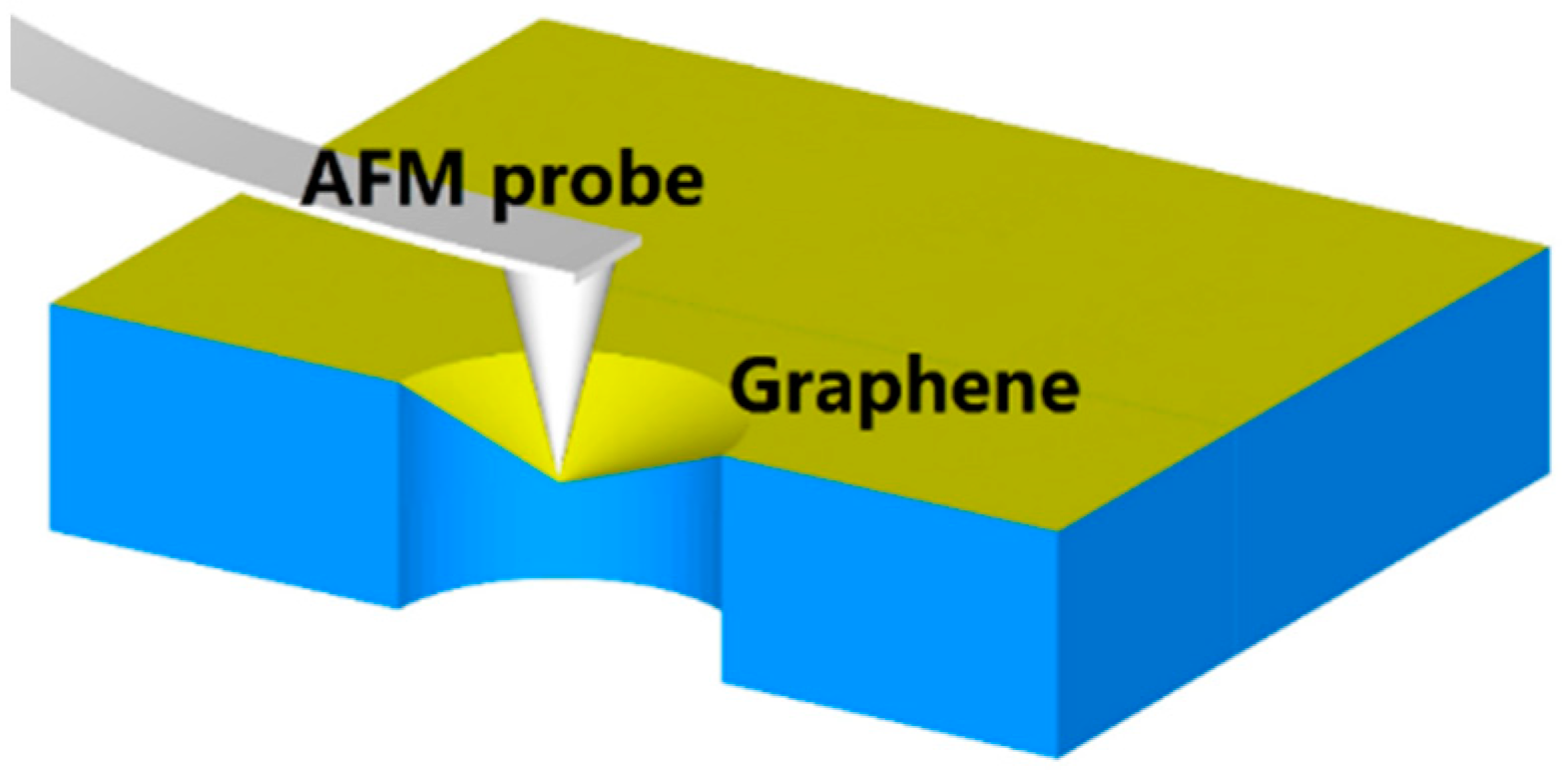
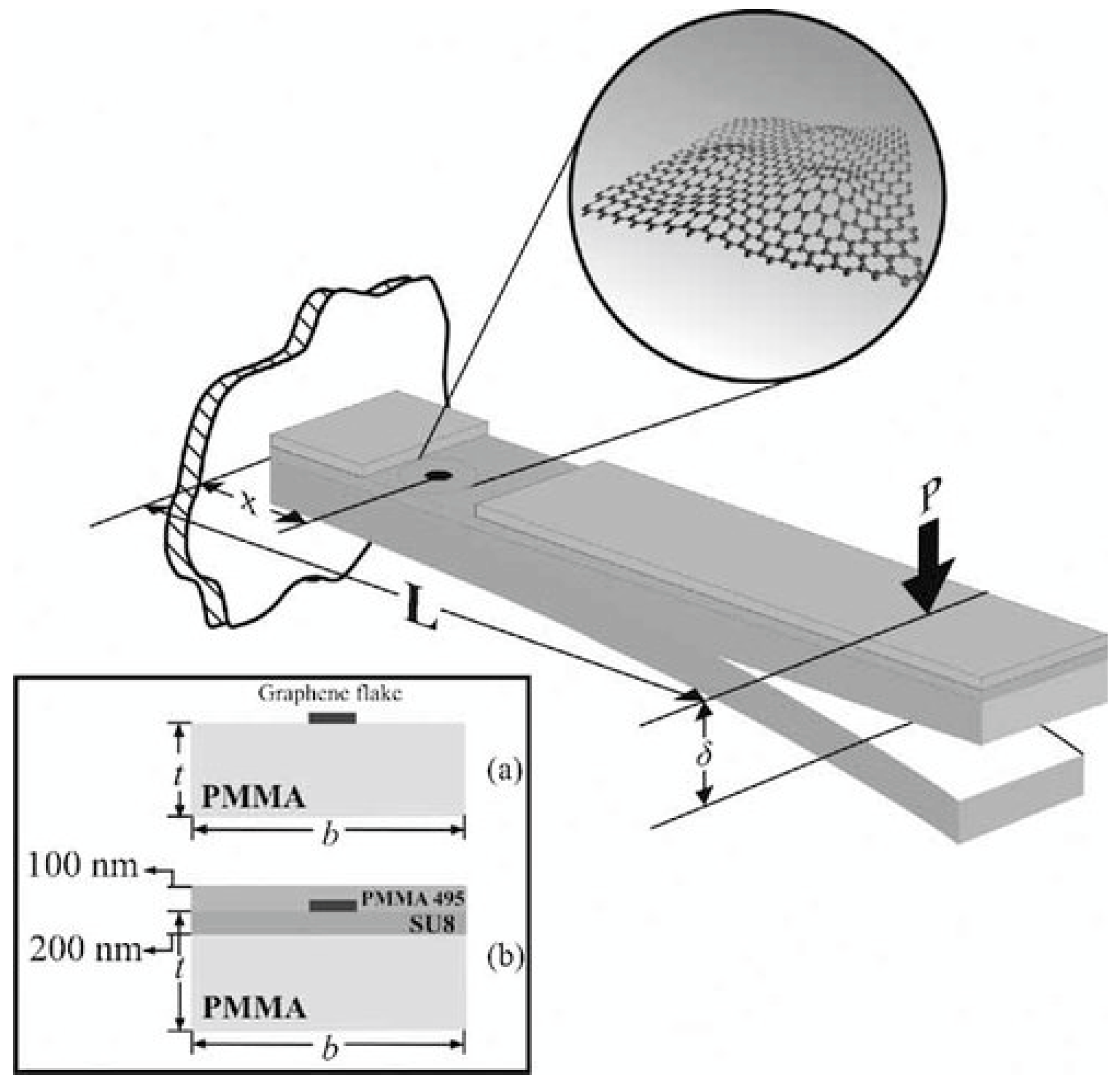
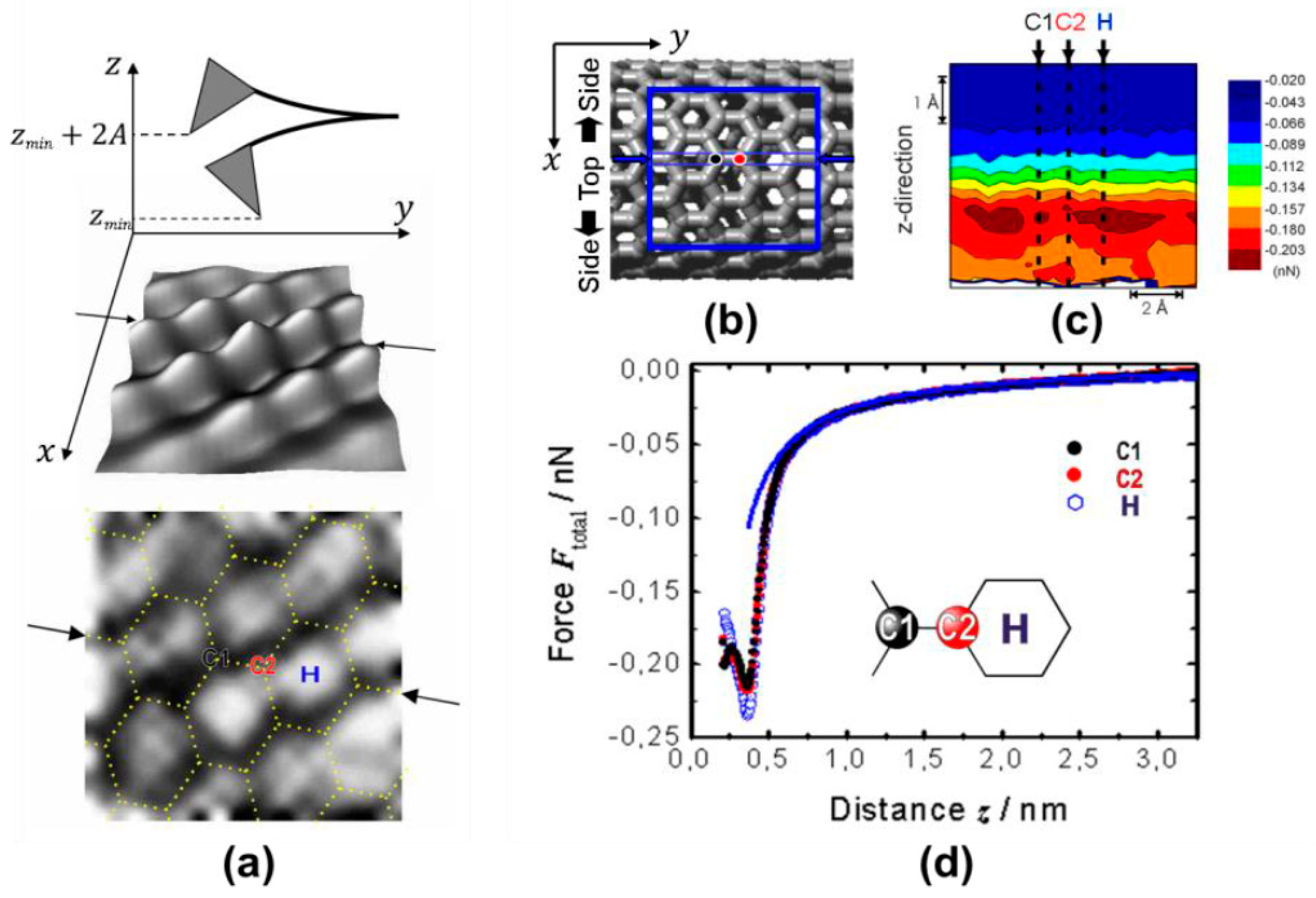
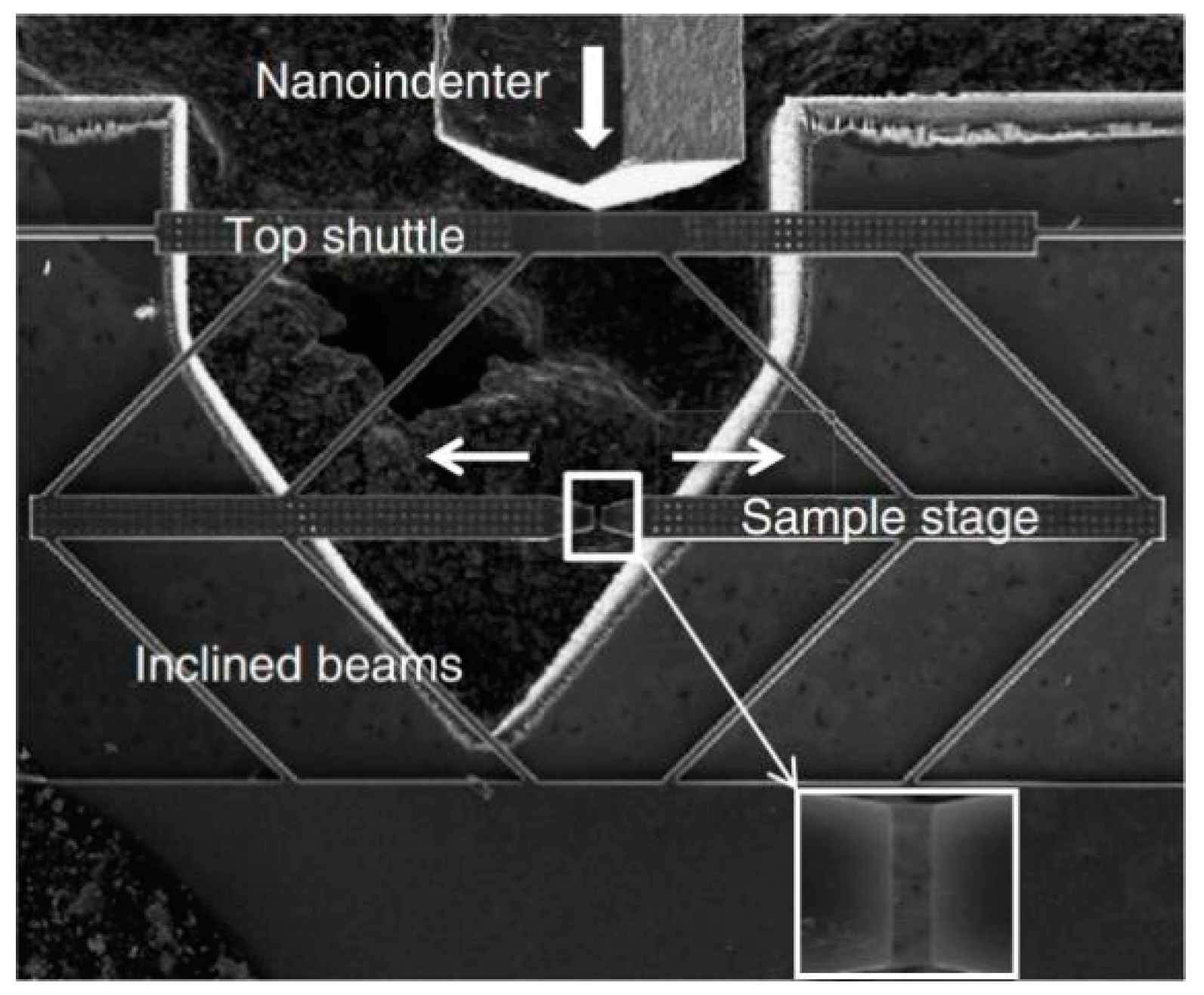
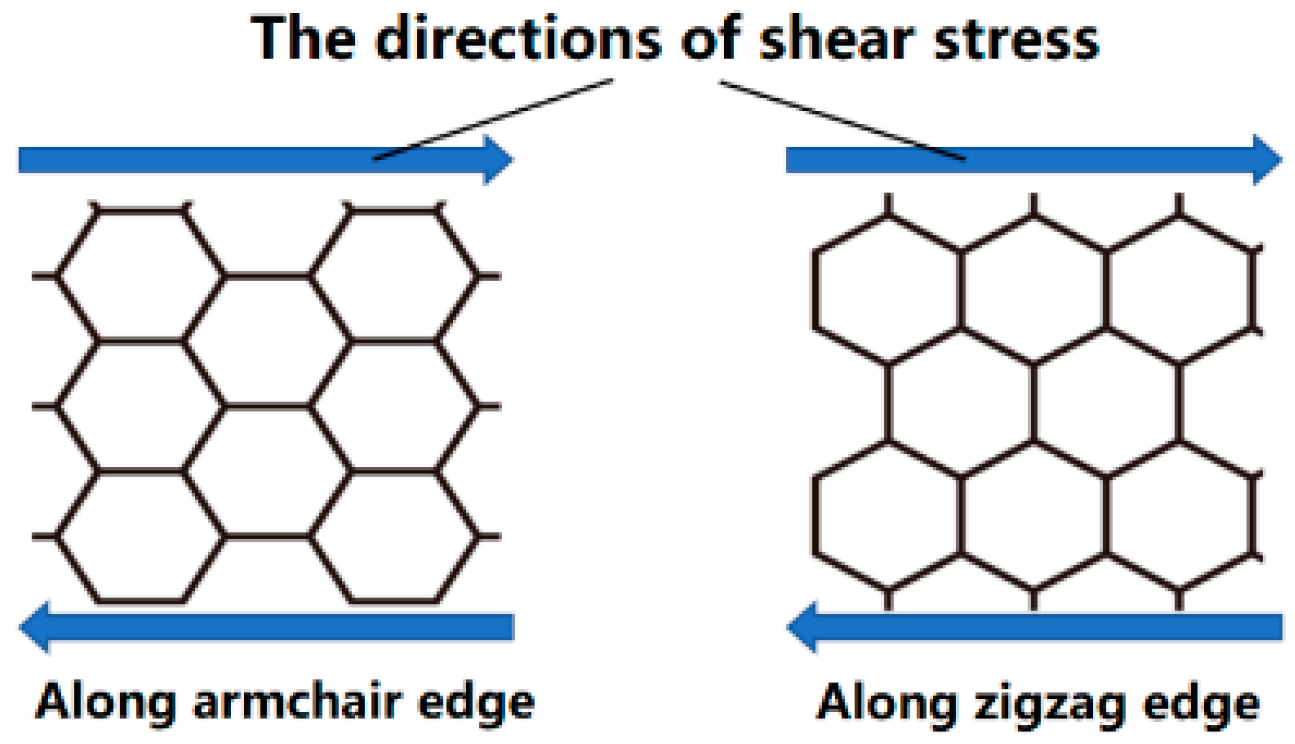

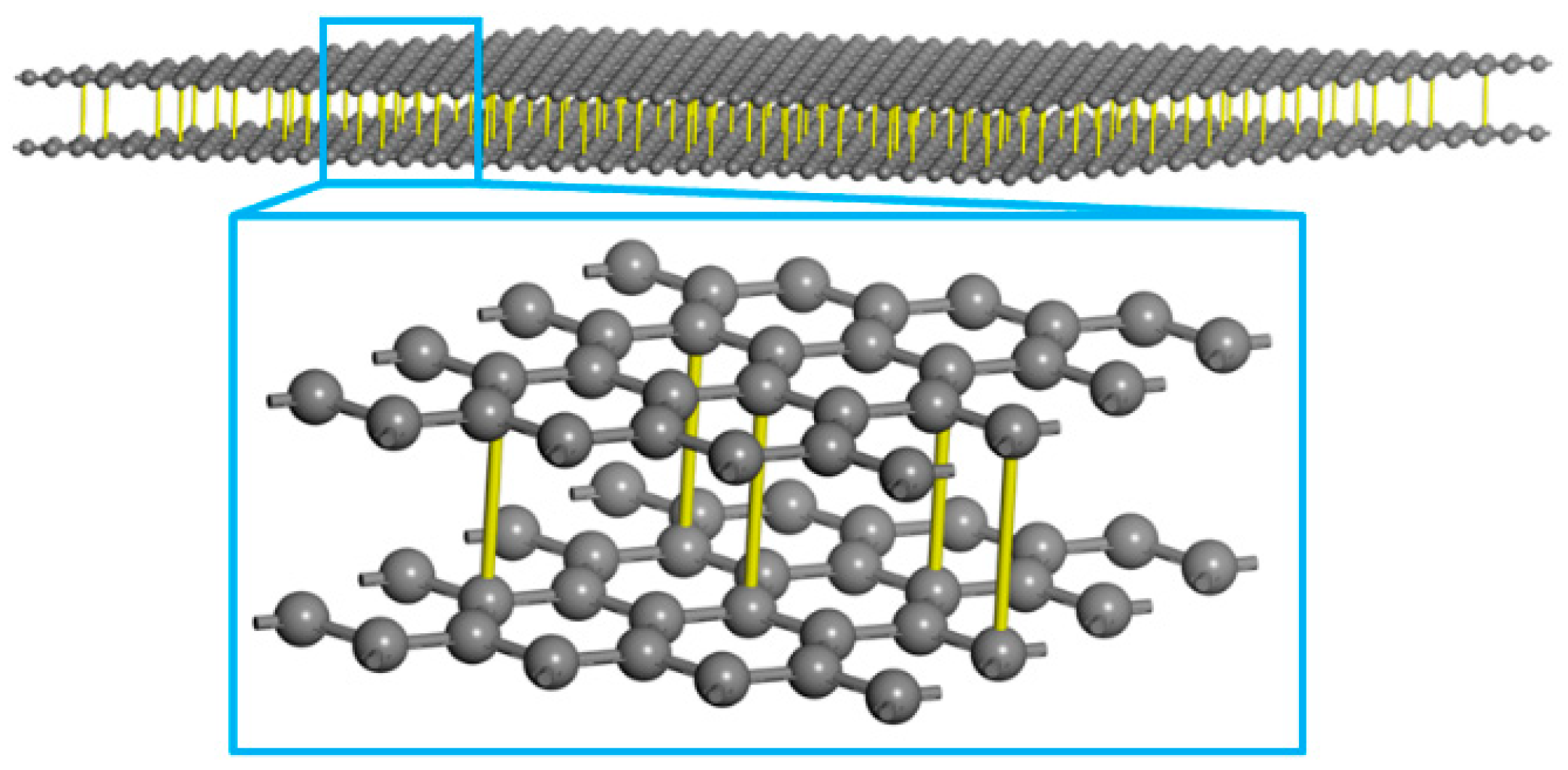

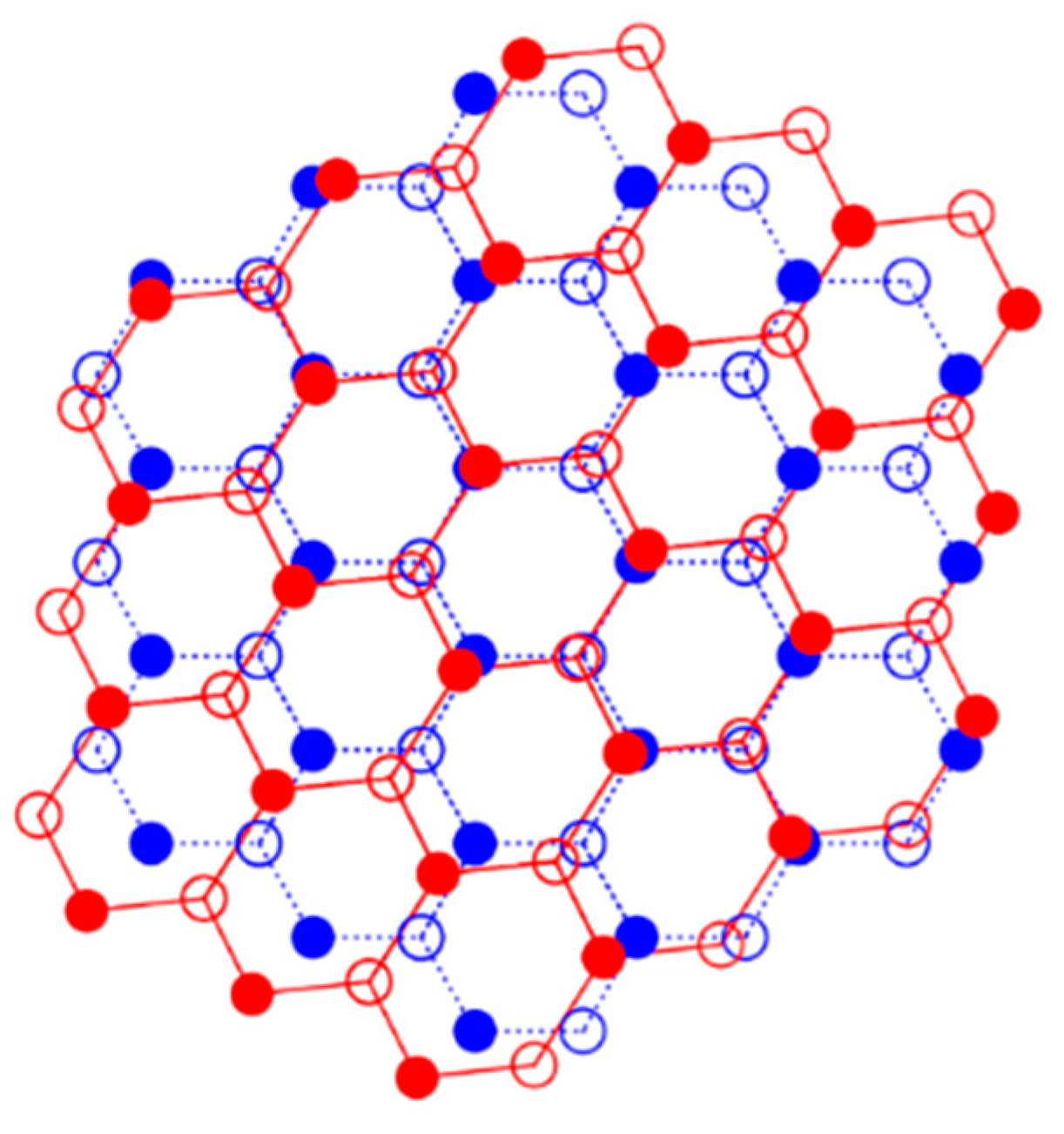
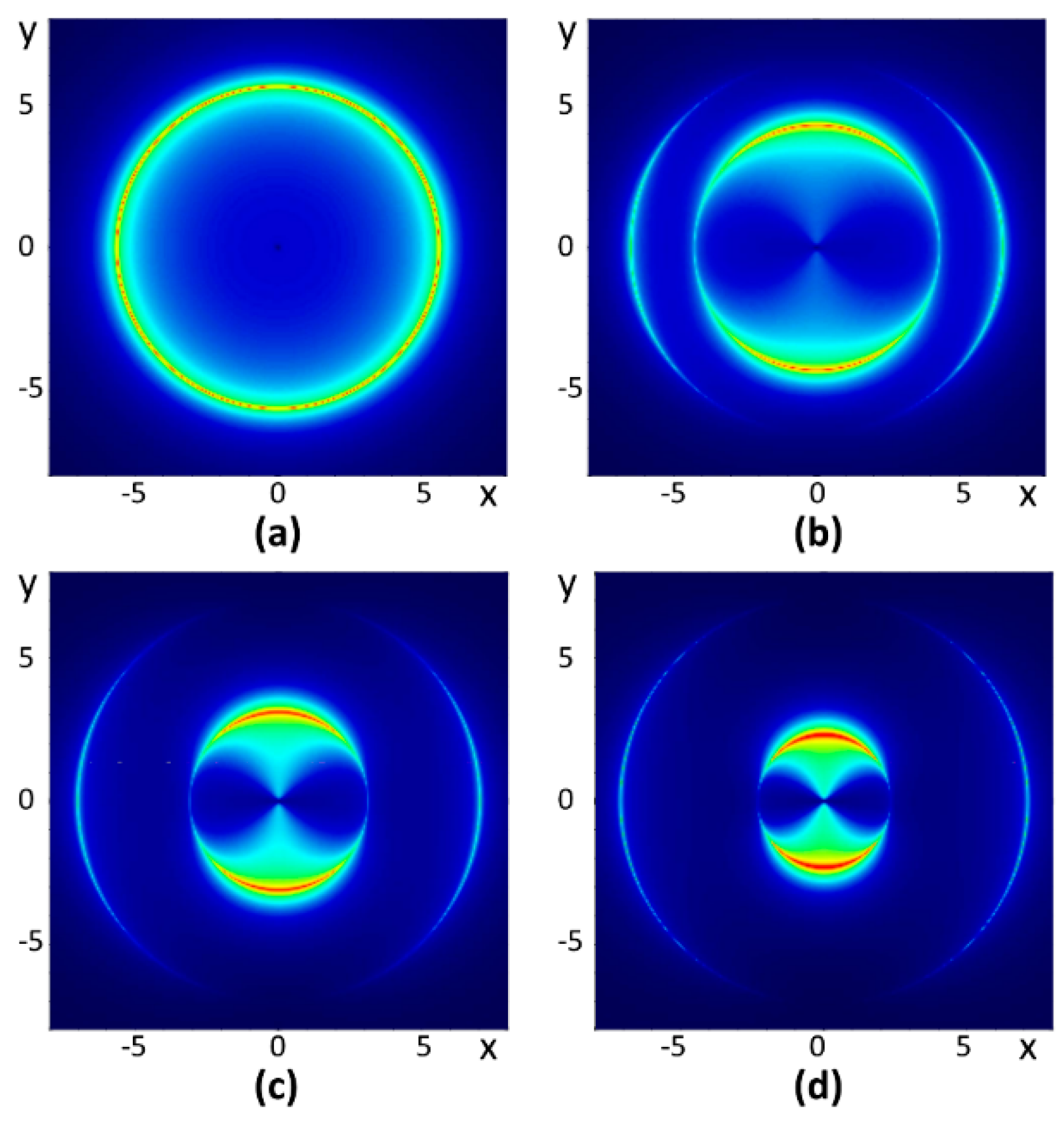
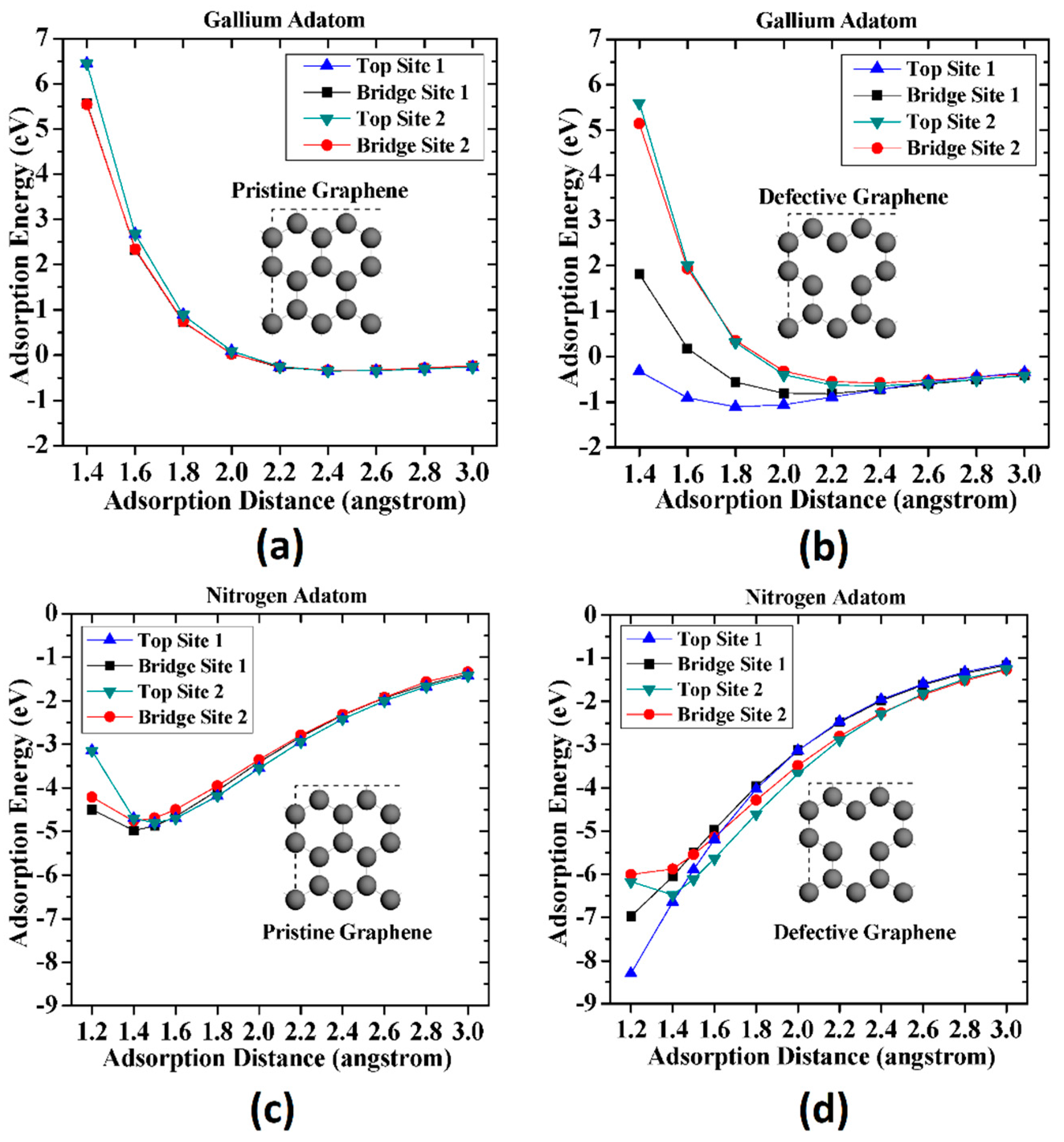
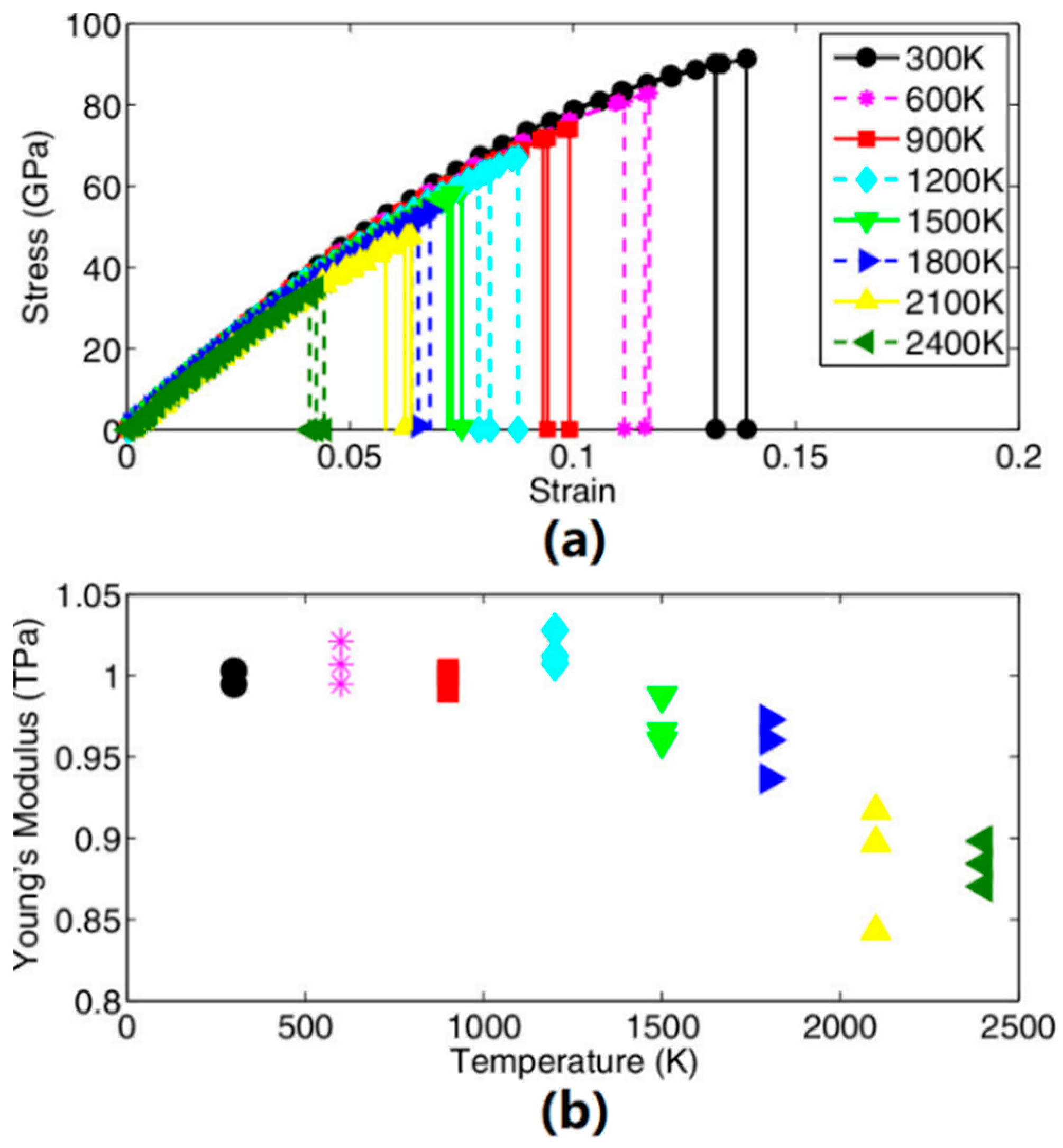
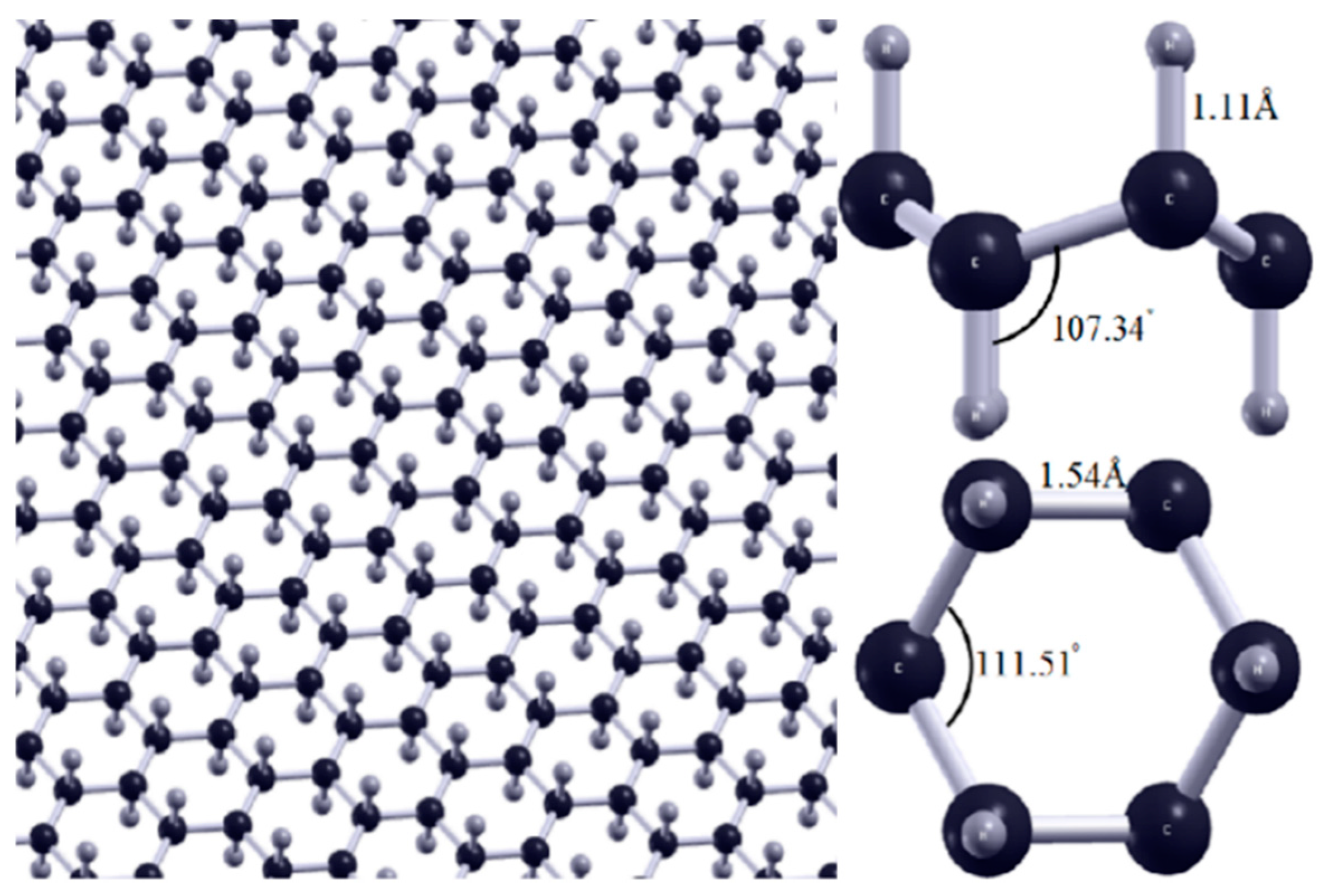
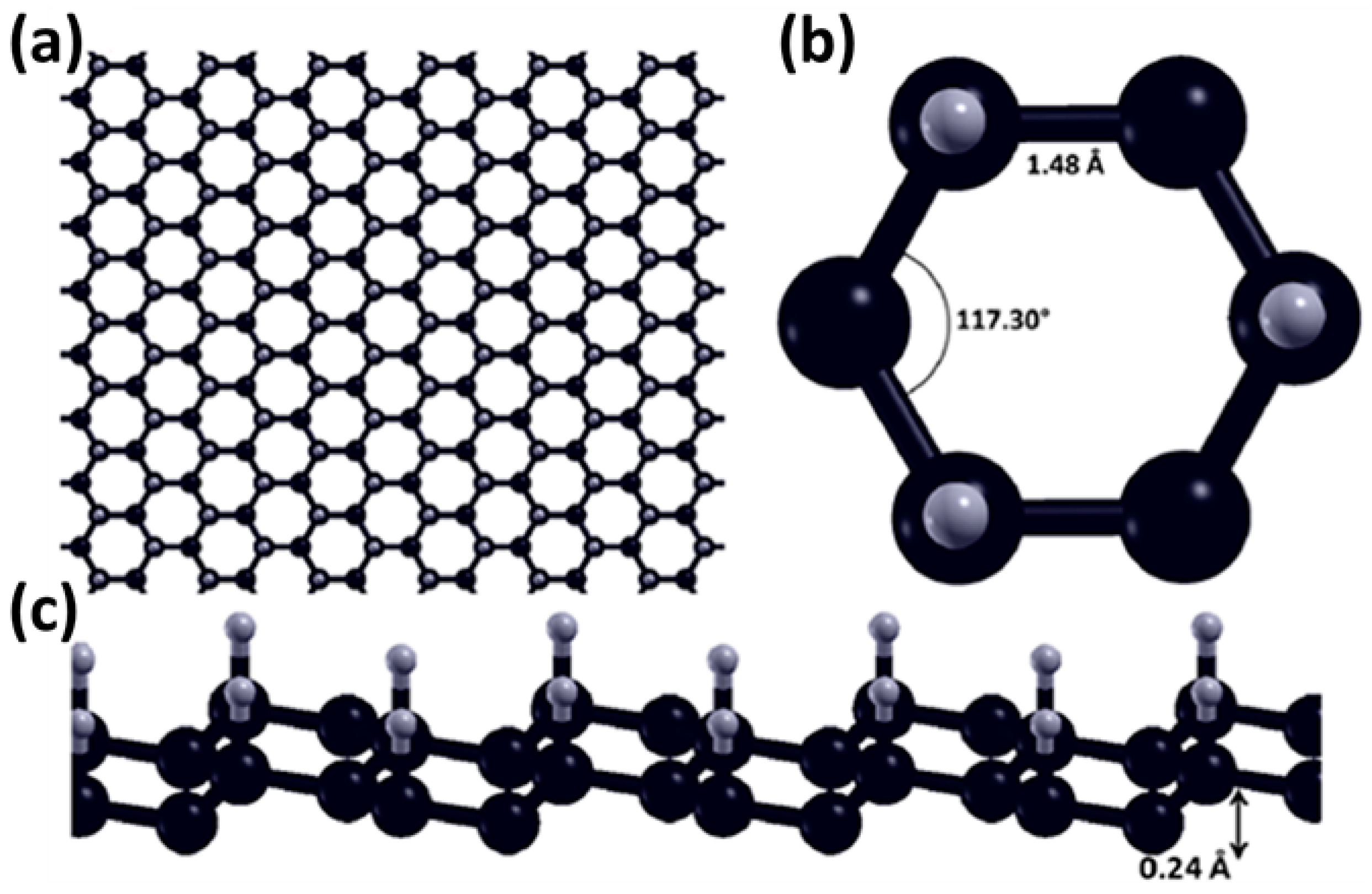
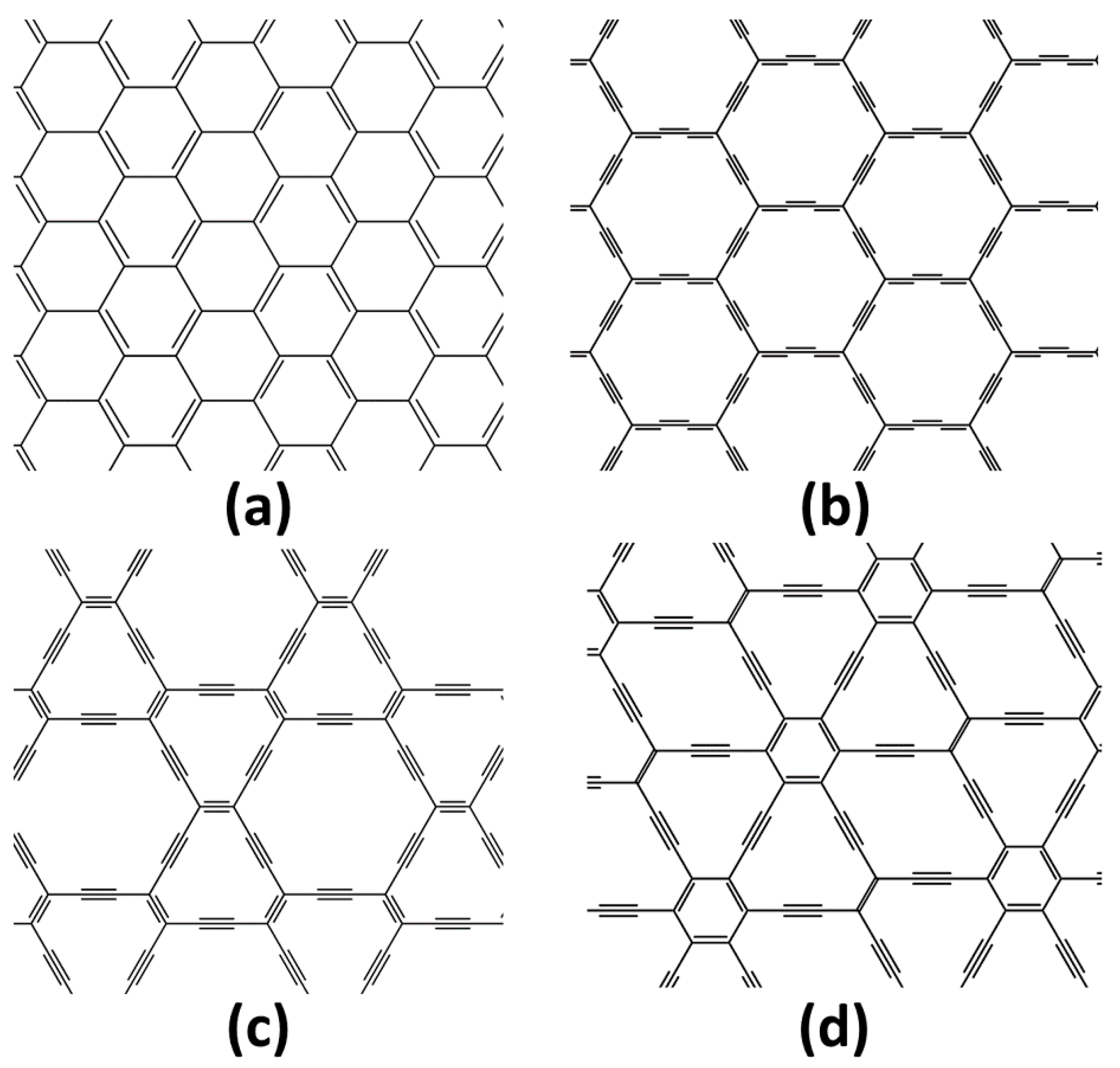
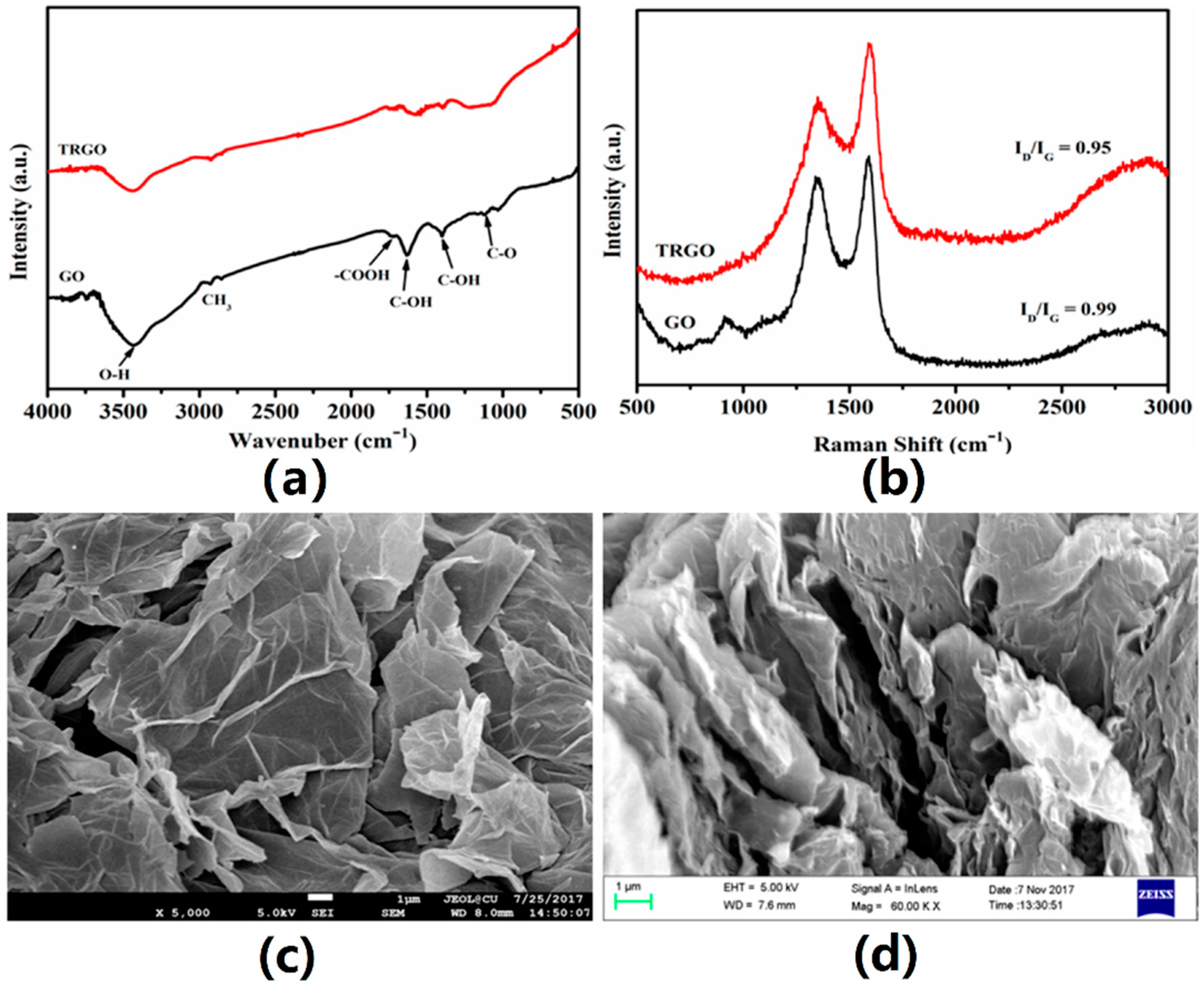
| Method | Young’s Modulus (TPa) | 2D Young’s Modulus (N/m) | Poisson’s Ratio | Strength(GPa) | Fracture Toughness (MPa ) |
| Experiment | |||||
| AFM-based nanoindentation [1] | 1.0 ± 0.1 [1] | 340 [1] | — | 130 (Intrinsic strength) [1] 90~94 [4] | — |
| In situ microscale tensile testing [5] | — | — | — | — | 4.0 ± 0.6 (for CVD graphene) [5] |
| Simulation | |||||
| Density functional theory (DFT) | 1.029 [6], 1.05 [7] | 345 [6] | 0.149 [6], 0.186 [7] | 110(a), 121(z) [7] | — |
| Monte Carlo simulation | ≈0.1 [8] | ||||
| Molecular dynamics (MD)/Molecular Mechanics (MM) simulation | 1.533(a), 1.111(z) (Morse) 0.879(a), 1.273(z) (AMBER) [9] 0.96 [10] | 320 [10] | 0.102~0.175 [9] 0.28 ± 0.03 [11] | 107(a), 90(z) [12] 86.84(a), 102.24(z) [13] | 3.44 [5] 3.38(a), 3.05(z) (Mode I) 2.87(a), 3.06(z) (Mode II) [14] |
| Finite element method (FEM)/Modified molecular-continuum model (MMC) | ≈1.03(a), ≈1.1(z) [2] 1.040(a), 0.992(z) [15] | ≈0.08(a), ≈0.06(z) [2] 1.285(a), 1.441(z) [15] | 98 [4] | 3.13(a), 1.99(z) (Mode I) 2.70(a), 3.73(z) (Mode II) [3] | |
| Method | Shear Modulus (GPa) | Shear Strength (GPa) | Bending Rigidity (Normal Bending Stiffness) (eV) | Gaussian Bending Stiffness (eV) | |
| Experiment | |||||
| Silicon DPO [16] | 280 (for CVD graphene) [16] | — | — | — | |
| Simulation | |||||
| Density functional theory (DFT) | — | — | 1.44 [17] | −1.52 [17] | |
| Molecular dynamics (MD)/Molecular Mechanics (MM) simulation | 36~96(a), 59~138(z) [18] 353(Morse), 277(AMBER) [9] 340~370(a), 430~470(z) (AIREBO) [19] | ≈60 [19] | 0.819~2.385 [20] | — | |
| Finite element method (FEM)/Modified molecular-continuum model | 228 [15] | — | — | — |
| Year | Researchers | Models/Methods | Subjects Investigated |
|---|---|---|---|
| 2008 | Sakhaee-Pour et al. [41] | Molecular structural mechanics [42,43] | Eigenfrequencies and mode shapes |
| 2009 | Hashemnia et al. [44] | Molecular structural mechanics [42,43] | Eigenfrequencies and mode shapes |
| 2010 | Sadeghi et al. [45] | A hybrid atomistic-structural element | Linear and nonlinear vibrations |
| 2010 | Gupta et al. [46] | Molecular mechanics (MM) and an equivalent continuum structure (ECS) | Eigenfrequencies of axial and bending modes of monolayer graphene with different charities, aspect ratios |
| 2010 | Ansari et al. [47] | A nonlocal elasticity model based on generalized differential quadrature (GDQ) method and molecular dynamics (MD) simulation. | Eigenfrequencies |
| 2010 | Scarpa et al. [48] | An equivalent atomistic-continuum finite element model | Eigenfrequencies and acoustic wave propagation characteristics of graphene nanoribbons |
| 2011 | Mianroodi et al. [49] | A membrane model | Nonlinear vibrational properties |
| 2011 | Chowdhury et al. [50] | Molecular mechanics (MM) | Transverse vibrations |
| 2012 | Bekir et al. [51] | Modified couple stress theory | The size effect on vibration of monolayer graphene on an elastic matrix |
| 2012 | Baykasoglu et al. [52] | A finite element method based on molecular mechanics (MM) | 2D and 3D modal and transient analyses |
| 2013 | Alyokhin et al. [53] | Molecular mechanics (MM) | Eigenfrequencies and the buckling modes |
| 2016 | Mirparizi et al. [54] | A finite element method based on molecular mechanics (MM) | Eigenfrequencies and mode shapes for cantilever and bridged monolayer graphene |
| Methods | Young’s Modulus (TPa) | Poisson’s Ratio | In-Plane Shear Modulus (GPa) | Intrinsic Strength (GPa) | |
|---|---|---|---|---|---|
| In situ microscale tensile testing [5] | — | — | — | — | 29.5 [55] |
| Molecular mechanics | 1.030 [56] | 0.195 [57] | 482 [58] | — | — |
| Molecular dynamics simulation (MD) | 0.8 [59], 0.795 [35] | 0.272 [35] | 318 [35] | — | — |
| Molecular structural mechanics (MM) | 1.007(a) 1.005(z) [60] | 0.0803(a) 0.112(z) [60] | 453.3 [60] | — | — |
| Density functional theory (DFT) | 0.867(AA), 0.977(AB), 0.953 ± 0.0214 (for twisted bilayer graphene) [61] | — | — | 96.97~111.23 (for twisted bilayer graphene) [61] | — |
© 2018 by the authors. Licensee MDPI, Basel, Switzerland. This article is an open access article distributed under the terms and conditions of the Creative Commons Attribution (CC BY) license (http://creativecommons.org/licenses/by/4.0/).
Share and Cite
Cao, Q.; Geng, X.; Wang, H.; Wang, P.; Liu, A.; Lan, Y.; Peng, Q. A Review of Current Development of Graphene Mechanics. Crystals 2018, 8, 357. https://doi.org/10.3390/cryst8090357
Cao Q, Geng X, Wang H, Wang P, Liu A, Lan Y, Peng Q. A Review of Current Development of Graphene Mechanics. Crystals. 2018; 8(9):357. https://doi.org/10.3390/cryst8090357
Chicago/Turabian StyleCao, Qiang, Xiao Geng, Huaipeng Wang, Pengjie Wang, Aaron Liu, Yucheng Lan, and Qing Peng. 2018. "A Review of Current Development of Graphene Mechanics" Crystals 8, no. 9: 357. https://doi.org/10.3390/cryst8090357
APA StyleCao, Q., Geng, X., Wang, H., Wang, P., Liu, A., Lan, Y., & Peng, Q. (2018). A Review of Current Development of Graphene Mechanics. Crystals, 8(9), 357. https://doi.org/10.3390/cryst8090357







